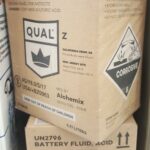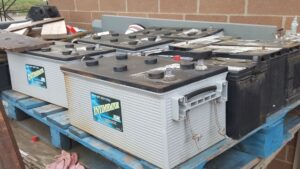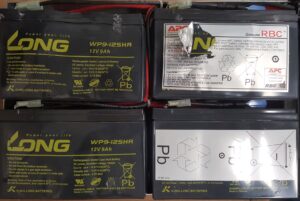The transportation of various fluid-filled batteries containing either an acid electrolyte or an alkaline corrosive battery fluid will require the use of one of the following proper shipping names from the Hazardous Materials Table at 49 CFR 172.101:
The first thing this tells us is that Wet Batteries, either filled with acid, filled with alkali, or non-spillable are a hazardous material when transported or offered for transportation in commerce. The purpose of this article is to identify and explain the packaging requirements of 49 CFR 173.159 for the transportation of Wet Batteries with a special emphasis on the exception from full compliance with the Hazardous Material Regulations (HMR) that’s available at §173.159(e).
After selecting the proper shipping name in column 2 of the Hazardous Materials Table, column 8 identifies the location in the HMR of the packaging instructions and any exceptions to regulation that may exist. You may note that all entries for Wet Batteries indicate the same location in the HMR for packaging instructions (bulk and non-bulk) and for exceptions: 49 CFR 173.159. Except for Batteries, wet, non-spillable, electric storage which have an exception all their own at §173.159a but that will be researched in another article. So, it is to §173.159 that a shipper must refer to determine what packaging is authorized for the transportation of Wet Batteries. I will summarize the requirements below.
49 CFR 173.159(a):
- Wet Batteries are described as electric storage batteries, containing either an acid electrolyte or an alkaline corrosive battery fluid.
- Wet Batteries may not be packed with other materials except for:
- Battery fluid if packaged pursuant to §173.159(g).
- Dry battery or a battery charger packaged pursuant to §173.159(h).
- Vehicles, equipment, or machinery packaged pursuant to §173.220.
- Dangerous goods in equipment, machinery, or apparatus packaged pursuant to §173.222.
- In addition to compliance with these packaging instructions, any battery or battery-powered device must be prepared and packaged for transport to prevent:
- A dangerous evolution of heat. i.e., anything that could damage the packaging or leaves visible evidence.
- Short circuits. The sub-paragraph (2) goes on to identify some methods to prevent short circuits, i.e., “including, but not limited to”.
- Damage to terminals. The sub-paragraph (3) goes on to identify some methods to prevent damage to battery terminals, i.e., “including, but not limited to”.
49 CFR 173.159(b):
If Wet Batteries are to be transported by aircraft:
- The packaging must incorporate an acid- or alkali-proof liner or supplementary packaging to prevent leakage of electrolyte fluid in the event of a spill.
And…
- Any battery-powered device, equipment, or vehicle must be packaged in a manner to prevent unintentional activation. Note that this requirement only applies to a battery-powered device, equipment, or vehicle, and not to a battery shipped individually.
Like this article? Subscribe to my Monthly Newsletter No marketing emails! |
49 CFR 173.159(c):
In addition to using the specification packaging identified below, batteries packed without other materials must comply with paragraph (a); and both (a) and (b) if transported by aircraft.
The following specification packagings are authorized:
- Wooden box: 4C1, 4C2, 4D, or 4F
- Fiberboard box: 4G
- Plywood drum: 1D
- Fiber drum: 1G
- Plastic drum: 1H2
- Plastic jerrican: 3H2
- Plastic box: 4H2
49 CFR 173.159(d):
In addition to using the non-specification packaging identified below, batteries packed without other materials must comply with paragraph (a); and both (a) and (b) if transported by aircraft.
The following non-specification packagings are authorized:
- Batteries firmly secured to skids or pallets are OK for transport by rail, highway, or vessel (but not aircraft). The paragraph goes on to detail height, width, and weight thresholds.
- Batteries of ≥500 lbs, consisting of carrier’s equipment, mounted on suitable skids, not for interchange service, may be transported by rail.
- One to three batteries of ≤25 lbs each, packed in strong outer box, with maximum gross weight (battery, packaging, and all) of 75 lbs.
- Not more than four batteries of ≤15 lbs each, packed in strong outer fiberboard or wooden boxes, with maximum gross weight (battery, packaging, and all) of 65 lbs.
- Not more than five batteries of ≤10 lbs each, packed in strong outer fiberboard or wooden boxes, with maximum gross weight (battery, packaging, and all) of 65 lbs.
- Single batteries of ≤75 lbs each, packed in 5-sided slip covers or in completely closed fiberboard boxes. The sub-paragraph (6) goes on to explain detailed requirements for the packaging.
- Single batteries of >75 lbs each, packed in completely closed fiberboard boxes. the sub-paragraph (7) goes on to explain detailed requirements for the packaging.
 49 CFR 173.159(e): “The Wet Battery Exception”
49 CFR 173.159(e): “The Wet Battery Exception”
Wet Batteries are not subject to any requirements of the Hazardous Material Regulations when transported in commerce if all of the following are true:
- Transportation must be by highway or rail.
- No other hazardous materials may be transported in the same vehicle.
- Batteries must be loaded or braced to prevent damage and short circuits in transit.
- Any other non-hazardous material loaded in the vehicle must be blocked, braced, or otherwise secured to prevent contact or damage to the batteries.
- Carrier can’t transport materials from anyone other than the shipper of the batteries.
49 CFR 173.159(f):
Batteries can be considered to be non-spillable (and thus subject to the packaging exception at §173.159a) if they can pass two tests without leakage of battery fluid.
- Vibration test. Read the sub-paragraph (1) for details.
- Pressure differential test. Read the sub-paragraph (2) for details.
49 CFR 173.159(g):
 If battery fluid, either electrolyte, acid or alkaline corrosive is packed with batteries (wet or dry) it must be in one of the following specification packagings:
If battery fluid, either electrolyte, acid or alkaline corrosive is packed with batteries (wet or dry) it must be in one of the following specification packagings:
- 4C1, 4C2, 4D, or 4F wooden boxes with inner receptacles of glass. Sub-paragraph (1) goes on to explain detailed requirements for the packaging.
- Sub-paragraph (2) identifies packaging requirements for battery fluid shipped by, for, or to the Departments of the Army, Navy, or Air Force of the United States.
- 4G fiberboard boxes with additional requirements described in sub-paragraph (3). These packages are not authorized for transportation by aircraft.
49 CFR 173.159(h):
Dry batteries or battery charger devices may be packaged in 4G fiberboard boxes with inner receptacles containing battery fluid. Further requirements for the packaging are described in the paragraph.
49 CFR 173.159(i):
An exception to the HMR is available for Wet Batteries that store battery fluid in a separate reservoir from which fluid is injected into the battery cells by a power device cartridge assembled with the battery, if the following is true:
- Batteries must meet criteria of “non-spillable” as described in §173.159(f).
- Associate Administrator of USDOT/PHMSA grants approval.
Batteries are a common article of our modern society. USDOT/PHMSA does what it can to ensure the safe transportation of this hazardous material while accommodating the needs of manufacturers and distributors. §173.159 is a good example of a regulation trying to strike a balance between safety and business.
Do you need HazMat Employee Training? Contact me!
Contact me with any questions you may have about the transportation of hazardous materials by air, highway, vessel, or rail International and Domestic Daniels Training Services 815.821.1550 |


 49 CFR 173.159(e): “The Wet Battery Exception”
49 CFR 173.159(e): “The Wet Battery Exception”